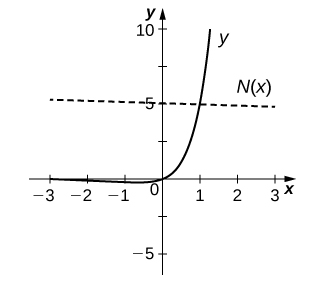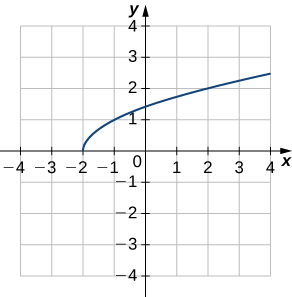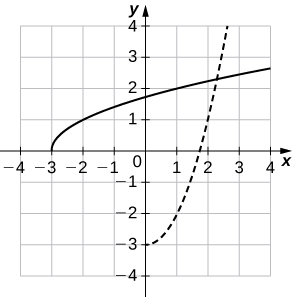3.9 E: Derivatives Ln, etc. Exercises
- Page ID
- 10870
\( \newcommand{\vecs}[1]{\overset { \scriptstyle \rightharpoonup} {\mathbf{#1}} } \)
\( \newcommand{\vecd}[1]{\overset{-\!-\!\rightharpoonup}{\vphantom{a}\smash {#1}}} \)
\( \newcommand{\id}{\mathrm{id}}\) \( \newcommand{\Span}{\mathrm{span}}\)
( \newcommand{\kernel}{\mathrm{null}\,}\) \( \newcommand{\range}{\mathrm{range}\,}\)
\( \newcommand{\RealPart}{\mathrm{Re}}\) \( \newcommand{\ImaginaryPart}{\mathrm{Im}}\)
\( \newcommand{\Argument}{\mathrm{Arg}}\) \( \newcommand{\norm}[1]{\| #1 \|}\)
\( \newcommand{\inner}[2]{\langle #1, #2 \rangle}\)
\( \newcommand{\Span}{\mathrm{span}}\)
\( \newcommand{\id}{\mathrm{id}}\)
\( \newcommand{\Span}{\mathrm{span}}\)
\( \newcommand{\kernel}{\mathrm{null}\,}\)
\( \newcommand{\range}{\mathrm{range}\,}\)
\( \newcommand{\RealPart}{\mathrm{Re}}\)
\( \newcommand{\ImaginaryPart}{\mathrm{Im}}\)
\( \newcommand{\Argument}{\mathrm{Arg}}\)
\( \newcommand{\norm}[1]{\| #1 \|}\)
\( \newcommand{\inner}[2]{\langle #1, #2 \rangle}\)
\( \newcommand{\Span}{\mathrm{span}}\) \( \newcommand{\AA}{\unicode[.8,0]{x212B}}\)
\( \newcommand{\vectorA}[1]{\vec{#1}} % arrow\)
\( \newcommand{\vectorAt}[1]{\vec{\text{#1}}} % arrow\)
\( \newcommand{\vectorB}[1]{\overset { \scriptstyle \rightharpoonup} {\mathbf{#1}} } \)
\( \newcommand{\vectorC}[1]{\textbf{#1}} \)
\( \newcommand{\vectorD}[1]{\overrightarrow{#1}} \)
\( \newcommand{\vectorDt}[1]{\overrightarrow{\text{#1}}} \)
\( \newcommand{\vectE}[1]{\overset{-\!-\!\rightharpoonup}{\vphantom{a}\smash{\mathbf {#1}}}} \)
\( \newcommand{\vecs}[1]{\overset { \scriptstyle \rightharpoonup} {\mathbf{#1}} } \)
\( \newcommand{\vecd}[1]{\overset{-\!-\!\rightharpoonup}{\vphantom{a}\smash {#1}}} \)
\(\newcommand{\avec}{\mathbf a}\) \(\newcommand{\bvec}{\mathbf b}\) \(\newcommand{\cvec}{\mathbf c}\) \(\newcommand{\dvec}{\mathbf d}\) \(\newcommand{\dtil}{\widetilde{\mathbf d}}\) \(\newcommand{\evec}{\mathbf e}\) \(\newcommand{\fvec}{\mathbf f}\) \(\newcommand{\nvec}{\mathbf n}\) \(\newcommand{\pvec}{\mathbf p}\) \(\newcommand{\qvec}{\mathbf q}\) \(\newcommand{\svec}{\mathbf s}\) \(\newcommand{\tvec}{\mathbf t}\) \(\newcommand{\uvec}{\mathbf u}\) \(\newcommand{\vvec}{\mathbf v}\) \(\newcommand{\wvec}{\mathbf w}\) \(\newcommand{\xvec}{\mathbf x}\) \(\newcommand{\yvec}{\mathbf y}\) \(\newcommand{\zvec}{\mathbf z}\) \(\newcommand{\rvec}{\mathbf r}\) \(\newcommand{\mvec}{\mathbf m}\) \(\newcommand{\zerovec}{\mathbf 0}\) \(\newcommand{\onevec}{\mathbf 1}\) \(\newcommand{\real}{\mathbb R}\) \(\newcommand{\twovec}[2]{\left[\begin{array}{r}#1 \\ #2 \end{array}\right]}\) \(\newcommand{\ctwovec}[2]{\left[\begin{array}{c}#1 \\ #2 \end{array}\right]}\) \(\newcommand{\threevec}[3]{\left[\begin{array}{r}#1 \\ #2 \\ #3 \end{array}\right]}\) \(\newcommand{\cthreevec}[3]{\left[\begin{array}{c}#1 \\ #2 \\ #3 \end{array}\right]}\) \(\newcommand{\fourvec}[4]{\left[\begin{array}{r}#1 \\ #2 \\ #3 \\ #4 \end{array}\right]}\) \(\newcommand{\cfourvec}[4]{\left[\begin{array}{c}#1 \\ #2 \\ #3 \\ #4 \end{array}\right]}\) \(\newcommand{\fivevec}[5]{\left[\begin{array}{r}#1 \\ #2 \\ #3 \\ #4 \\ #5 \\ \end{array}\right]}\) \(\newcommand{\cfivevec}[5]{\left[\begin{array}{c}#1 \\ #2 \\ #3 \\ #4 \\ #5 \\ \end{array}\right]}\) \(\newcommand{\mattwo}[4]{\left[\begin{array}{rr}#1 \amp #2 \\ #3 \amp #4 \\ \end{array}\right]}\) \(\newcommand{\laspan}[1]{\text{Span}\{#1\}}\) \(\newcommand{\bcal}{\cal B}\) \(\newcommand{\ccal}{\cal C}\) \(\newcommand{\scal}{\cal S}\) \(\newcommand{\wcal}{\cal W}\) \(\newcommand{\ecal}{\cal E}\) \(\newcommand{\coords}[2]{\left\{#1\right\}_{#2}}\) \(\newcommand{\gray}[1]{\color{gray}{#1}}\) \(\newcommand{\lgray}[1]{\color{lightgray}{#1}}\) \(\newcommand{\rank}{\operatorname{rank}}\) \(\newcommand{\row}{\text{Row}}\) \(\newcommand{\col}{\text{Col}}\) \(\renewcommand{\row}{\text{Row}}\) \(\newcommand{\nul}{\text{Nul}}\) \(\newcommand{\var}{\text{Var}}\) \(\newcommand{\corr}{\text{corr}}\) \(\newcommand{\len}[1]{\left|#1\right|}\) \(\newcommand{\bbar}{\overline{\bvec}}\) \(\newcommand{\bhat}{\widehat{\bvec}}\) \(\newcommand{\bperp}{\bvec^\perp}\) \(\newcommand{\xhat}{\widehat{\xvec}}\) \(\newcommand{\vhat}{\widehat{\vvec}}\) \(\newcommand{\uhat}{\widehat{\uvec}}\) \(\newcommand{\what}{\widehat{\wvec}}\) \(\newcommand{\Sighat}{\widehat{\Sigma}}\) \(\newcommand{\lt}{<}\) \(\newcommand{\gt}{>}\) \(\newcommand{\amp}{&}\) \(\definecolor{fillinmathshade}{gray}{0.9}\)3.9: Derivatives of Ln, General Exponent & Log Functions; and Logarithmic Differentiation
Exercise:
For the following exercises, find \(f′(x)\) for each function.
333) \(f(x)=e^{x^3\ln x}\)
- Answer:
-
\(e^{x^3}\ln x(3x^2\ln x+x^2)\)
336) \(f(x)=\frac{10^x}{\ln10}\)
337) \(f(x)=2^{4x}+4x^2\)
- Answer:
-
\(2^{4x+2}⋅\ln 2+8x\)
338) \(f(x)=3^{\sin(3x)}\)
339) \(f(x)=x^π⋅π^x\)
- Answer:
-
\(πx^{π−1}⋅π^x+x^π⋅π^x\ln π\)
340) \(f(x)=\ln(4x^3+x)\)
341) \(f(x)=\ln\sqrt{5x−7}\)
- Answer:
-
\(\frac{5}{2(5x−7)}\)
342) \(f(x)=x^2\ln(9x)\)
343) \(f(x)=log(\sec x)\)
- Answer:
-
\(\frac{\tan x}{\ln10}\)
344) \(f(x)=log_7(6x^4+3)^5\)
345) \(f(x)=2^x⋅log_37^{x^2−4}\)
- Answer:
-
\(2^x⋅\ln 2⋅log_37^{x^2−4}+2^x⋅\frac{2x\ln 7}{\ln 3}\)
For the following exercises, use logarithmic differentiation to find \(\frac{dy}{dx}\).
346) \(y=x^{\sqrt{x}}\)
347) \(y=(\sin(2x))^{4x}\)
- Answer:
-
\((\sin(2x))^{4x}[4⋅ln(\sin(2x))+8x⋅\cot(2x)]\)
348) \(y=(\ln x)^{\ln x}\)
349) \(y=x^{log_2x}\)
- Answer:
-
\(x^{log_2x}⋅\frac{2\ln x}{x\ln 2}\)
350) \(y=(x^2−1)^{\ln x}\)
351) \(y=x^{\cot x}\)
- Answer:
-
\(x^{\cot x}⋅[−\csc^2x⋅lnx+\frac{\cot x}{x}]\)
352) \(y=\frac{x+11}{\sqrt[3]{x^2−4}}\)
353) \(y=x^{−1/2}(x^2+3)^{2/3}(3x−4)^4\)
- Answer:
-
\(x^{−1/2}(x^2+3)^{2/3}(3x−4)^4⋅[\frac{−1}{2x}+\frac{4x}{3(x^2+3)}+\frac{12}{3x−4}]\)
354) [T] Find an equation of the tangent line to the graph of \(f(x)=4xe^{(x^2−1)}\) at the point where
\(x=−1.\) Graph both the function and the tangent line.
355) [T] Find the equation of the line that is normal to the graph of \(f(x)=x⋅5^x\) at the point where \(x=1\). Graph both the function and the normal line.
- Answer:
-
\(y=\frac{−1}{5+5\ln 5}x+(5+\frac{1}{5+5\ln 5})\)

356) [T] Find the equation of the tangent line to the graph of \(x^3−x\ln y+y^3=2x+5\) at the point where \(x=2\). (Hint: Use implicit differentiation to find \(\frac{dy}{dx}\).) Graph both the curve and the tangent line.
J357)
use the graph of \(y=f(x)\) (shown below) to
a. sketch the graph of \(y=f^{−1}(x)\), and
b. use part a. to estimate \((f^{−1})′(1)\).

- Answer:
-
a.

b. \((f^{−1})′(1)~2\)
For the next set of exercises, find \(\frac{dy}{dx}\). [Hint: first take the ln of both sides.]
J358) \(y=\frac{(2x^3−15x)\sqrt{6x^{4}+7}}{3x^2−x+3}\)
J359) \(y={30x^4}\sqrt{17x+2}{(\sin(x))}\)
J360) \(y={e^{5x}}{(3x-1)^\frac{2}{3}}{(8^{3x})}\)

